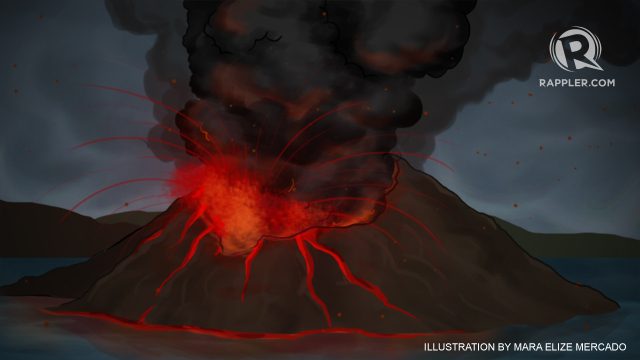SUMMARY
This is AI generated summarization, which may have errors. For context, always refer to the full article.

MANILA, Philippines – Taal Volcano is one of the 24 active volcanoes listed by the Philippine Institute of Volcanology and Seismology (Phivolcs). It is also one of the world’s lowest and deadliest volcanoes.
Located in Batangas, a province 60 kilometers south of Manila, Taal Volcano and the area around it have become one of the most frequented vacation spots in Southern Luzon. Although it is classified as an active volcano, it hasn’t erupted in 43 years or since 1977.
The volcano consists of multiple stratovolcanoes and craters. Since 1572, it has recorded 34 eruptions.
The eruptions were not all similar. Most of them were caused by the interaction of magma and water (phreatic and phreatomagmatic). Others were caused by the rising of bubbles formed by the fusion of gas inside the volcano (strombolian).
In phreatic eruptions, only preexisting solid rock fragments are ejected. In contrast, phreatomagmatic eruptions shoot out magma. (READ: FAST FACTS: Phreatic and other types of volcanic eruption)
Here’s a timeline of Taal Volcano eruptions, according to Phivolcs.
1572 – A phreatomagmatic eruption occurred at the main crater of the volcano.
1591, 1605 to 1611, 1634, 1635, 1641, 1645 – Separate eruptions occurred in these periods at the main crater. In 1591 and 1641, the eruptions were classified as phreatic. Tephra or rock particles and fragments were also visible in the 1641 incident.
1707 – Taal Volcano erupted at its Binintiang Malaki crater or its largest flank cone that’s visible from Tagaytay City. It is said that the Binintiang Malaki was formed during this eruption. It was classified as phreatic, and shock waves were also reported. Another eruption occurred in the area in 1715.
September 21, 1716 – An underwater, phreatomagmatic eruption occurred at Calauit, which is located at the eastern shore of the Taal Volcano island.
1709, 1729 – Separate eruptions occurred at its Binintiang Munti crater. The 1709 incident was classified as phreatomagmatic.
1731 – An underwater eruption happened in Pira-Piraso, or the eastern tip of the island. This was classified as phreatomagmatic. Flowing mixture of gas and ejected rock fragments were reported, as well as falling of rock particles.
August 11, 1749 – The main crater had a phreatomagmatic eruption and was recorded as “very violent” by Phivolcs. It affected residents of Taal Volcano Island and lakeshore towns of Taal, Sala, and Tanauan.
May 15 to December 5, 1754 – A phreatomagmatic/plinian eruption took place, characterized by a “very violent” explosion accompanied by falling and ejection of rock particles. A plinian eruption is characterized by continuous gas blasts and explosive ejection of viscous lava.
This incident is considered Taal Volcano’s biggest eruption yet and lasted almost 7 months. It buried 4 towns in Batangas under ash, volcanic rocks, and water. Ashfall registering 100 to 110-centimeter deposits was reported, as well as shock waves and acid rain. (READ: Taal 1754 eruption: Will history repeat itself?)
1790, 1808, 1825, 1842, 1873, 1874, 1878, 1903, 1904 – Separate eruptions occurred at the main crater. The 1808 and 1874 eruptions were classified as phreatomagmatic, while the 1878 and 1904 were phreatic.
January 27 to February 10, 1911 – A phreatic and “very violent” eruption occurred at the main crater, causing rock particles and fragments to fall and shoot out of the volcano. Phivolcs recorded 1,335 casualties in this incident.
There were also 25 to 80-centimeter thick deposit of ashfall, acid rain, shock waves, and cracking and sinking of land.
September 28 to 30, 1965 – Taal Volcano erupted at Mt Tabaro, leaving 200 casualties, according to Phivolcs. The eruption was phreatomagmatic and violent, characterized by falling of rock fragments, ashfall with 25-centimeter thick deposit, and acid rain.
July 5, 1966; August 16, 1967 – Separate phreatomagmatic eruptions occurred again at the Mt Tabaro crater. Both incidents caused rock particles to fall from the volcano and shoot out in projectile motion.
January 31, 1968; October 29, 1969 – The only Strombolian eruptions of Taal Volcano were recorded on these dates, which both happened at the Mt Tabaro crater. Lava flow and fountaining happened in both incidents.
September 3, 1970; September 3, 1976; October 3, 1977 – The last 3 eruptions that occurred before the 2020 explosion. These eruptions were similar in nature – they all took place at the Mt Tabaro crater and were all phreatic.
Taal Volcano hasn’t erupted since 1977, as confirmed by Renato Solidum, Department of Science and Technology undersecretary for disaster risk reduction and climate change adaptation. However, there had been volcanic unrest recorded in 2011, 2012, and 2014. – Rappler.com
Read Rappler explainers on Taal Volcano:
Add a comment
How does this make you feel?
There are no comments yet. Add your comment to start the conversation.